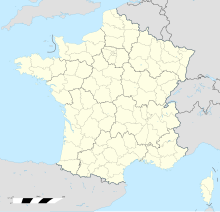Draft:Battle of Redon (1815)
 | Review waiting, please be patient.
This may take 8 weeks or more, since drafts are reviewed in no specific order. There are 1,832 pending submissions waiting for review.
Where to get help
How to improve a draft
You can also browse Wikipedia:Featured articles and Wikipedia:Good articles to find examples of Wikipedia's best writing on topics similar to your proposed article. Improving your odds of a speedy review To improve your odds of a faster review, tag your draft with relevant WikiProject tags using the button below. This will let reviewers know a new draft has been submitted in their area of interest. For instance, if you wrote about a female astronomer, you would want to add the Biography, Astronomy, and Women scientists tags. Editor resources
Reviewer tools
|
| Battle of Redon | |||||
|---|---|---|---|---|---|
 Abside de l'église Saint-Sauveur à Redon, engraving by Thomas Drake, circa 1850. | |||||
| |||||
| Belligerents | |||||
|
| Chouan | ||||
| Commanders and leaders | |||||
|
|
Louis de Sol de Grisolles Marc-Antoine de La Boëssière de Lennuic Joseph de Cadoudal Yves Le Thieis Louis Joseph de Margadel Julien Guillemot Claude-René Guezno de Penanster Louis-Jacques de Sécillon Jean Rohu Guillaume Gamber | ||||
| Units involved | |||||
| 120 individuals[1] | 5,000 individuals[1] | ||||
| Casualties and losses | |||||
|
4 dead[2] 6 injured[3] |
7 to 12 dead[2] 30 to 50 injured[2][4] | ||||
Location within France | |||||
The Battle of Redon, fought on June 4, 1815, was a significant clash during the Chouannerie of 1815, where the royalist Chouan forces led by Louis de Sol de Grisolles attacked the town of Redon. Despite their numerical advantage of 4,000–5,000 troops against a small Imperial garrison of 120 men, the Chouans could not capture the town due to their lack of artillery and withdrew after intense fighting.
Events
[edit]
On June 4, 1815, the Chouan army of Louis de Sol de Grisolles, comprising a force of between 4,000 and 5,000 men, launched an assault on the town of Redon, situated at the southwestern extremity of the Ille-et-Vilaine department.[1][3] The Imperial forces comprised only 120 men, including 100 soldiers from the 11th Light Infantry Regiment and approximately twenty volunteers.[1][3] These were under the command of Battalion Chief Cagnazzoli[1][3] and Sub-Prefect Baymé, a former squadron leader.[1][5]
The Imperial forces established a defensive position at advanced posts along the avenues leading into the town.[1] However, the Chouans, possessing a significantly larger number of troops, could dislodge them from the suburb's main street on the road to Rennes, situated to the north of the town, as well as from the Codilo district to the west. In this latter instance, the gendarmes, concealed within the vineyards, were circumvented by a detachment of insurgents who had gained access to the area through Parc Anger.[1]
The Imperial forces then withdrew to the town hall, which was barricaded, while approximately twenty of their number sought refuge in the bell tower of the Saint-Sauveur Abbey.[1] Meanwhile, the inhabitants of Redon allied with the royalists.[1]
However, the Chouans were lacking in artillery and could not overcome the last Imperial strongholds.[1] Furthermore, Sol de Grisolles refused to set fire to the besieged buildings, fearing the fire might spread to the town.[1] Ultimately, the Chouans were forced to evacuate Redon[1] and withdraw to Peillac.[4]
Casualties
[edit]In his summary of the 1815 campaign, royalist officer Marc-Antoine de La Boëssière de Lennuic reports that 17 soldiers and gendarmes were killed during the fighting.[6] Charles-Louis Chassin, in his account, states losses of three dead and six wounded.[3] In 2015, historian Aurélien Lignereux gave a total of four dead.[2]
In his memoirs,[A 1] Chouan officer Julien Guillemot states that the number of casualties on their side was seven killed and approximately thirty wounded.[4] According to La Boëssière de Lennuic, the royalist casualties included six or seven fatalities and approximately thirty individuals wounded, including officers Courson, Breteché, Pioger, Hervieux, and Le Car.[6] Historian Aurélien Lignereux estimates that between seven and twelve individuals were killed and approximately fifty were wounded.[2] Langourla, a young nobleman from Josselin, was among the deceased.[7]
Notes
[edit]- ^
On June 4, the Royal Army entered the town of Redon; but lacking artillery, they were unable to capture an old crenelated tower there, in which the garrison had safely taken refuge. The garrison defended itself courageously and inflicted considerable losses on the Chouans.
The brave young Langourla, the last offspring of an old noble family, was killed as he charged toward this tower. Six others perished with him, and about thirty were wounded, among whom were Pierre Le Cars, known as Pelo, from Caden, one of the oldest and bravest officers in the Royal Army; the brave Mathurin Charrier, former grenadier captain of the Bignan Battalion; your father, who had his thigh pierced by a bullet; and Mr. Hervieu, a young man from Vannes, well-known for his steadfastness and noble character.[4]— Memoirs of Julien Guillemot
References
[edit]Bibliography
[edit]- Chassin, Charles-Louis (1899). Les pacifications de l'Ouest, 1794-1801-1815 [The pacifications of the West, 1794-1801-1815] (in French). Vol. III. Paris: Plon.
- Guillemot, Julien (1859). Lettres à mes neveux sur la Chouannerie [Letters to my nephews on the Chouannerie] (in French). Imprimerie Félix Masseaux. Archived from the original on June 15, 2024.
- La Borderie, Arthur (1869). Revue de Bretagne et de Vendée [Review of Brittany and Vendé] (in French). Vol. V - Troisième série (Tome XXV de la collection). Nantes: Bureau de rédaction et d'abonnement. Archived from the original on May 24, 2021.
- Lignereux, Aurélien (2015). Chouans et Vendéens contre l'Empire, 1815. L'autre Guerre des Cent-Jours [Chouans and Vendéens against the Empire, 1815. The other Hundred Days' War] (in French). Paris: Éditions Vendémiaire. ISBN 978-2363581877.

